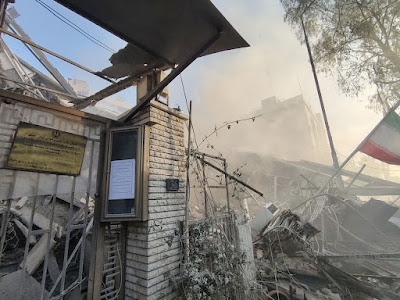The Syrian Air Force (SYAF), officially the Syrian Arab Air Force, operates three Ilyushin IL-76T (NATO: Candid) heavy lift transport aircraft: YK-ATA, YK-ATB, and YK-ATD (shown top to bottom). A fourth aircraft (YK-ATC) has not been operational for almost 30 years.
These are older photos – all three aircraft are in need of depot-level maintenance, upgrade, and overhaul. This
is done at at the Ilyushin facility in Ramenskoye, Russia. Based on publicly available flight tracking information, YK-ATD was overhauled in 2016, YK-ATB in 2018, and YK-ATA in 2019.
I suspect that YK-ATD is in dire need of major maintenance - it has not flown since November 24, 2022, and then only for a short domestic flight. It appears to have become what we in the U.S. Air Force refer to as a “hangar queen.”
Do not let the colorful livery of SYRIANAIR (Syrian Airlines) fool you – I have flown on both SYRIANAIR and with the SYAF - they’re different. One is a second-tier Middle East airline with great passenger service, and the other is a third-rate air force transport operation that worried me. I have flown on SYAF Antonov AN-24 (NATO: Coke), Tupolev TU-134 (NATO: Crusty), and Yakovlev YAK-40 (NATO: Codling) aircraft – the condition of the YAK-40 and AN-24 was far below U.S. Air Force standards.
The three IL-76 aircraft are actually assigned to the 585th Transport Squadron of the Syrian Air Force 29th Air Transport Brigade, based at Damascus International Airport.
The military ramp at the airport is southwest of the civilian terminal. I have been on the 29th Brigade ramp a few times to catch attaché flights on the extremely rare occasions when the Syrians included American officers in official attaché trips.
These transports were built in 1980 (YK-ATA and YK-ATB) and 1981 (YK-ATD) – I remember them in the original IL-76MD (military) configuration, complete with tail guns. In the early 2000s, all were converted to their current IL-76T configuration.
Over the past few years, the Syrian IL-76’s made almost daily resupply flights to the regime-controlled enclave of al-Qamishly in northeast Syria, and almost daily flights to Mehrabad airport in Tehran, Iran. Once in a while, one of the aircraft would fly to/from Moscow.
That pattern has changed a bit.
I have noticed a massive increase of SYAF IL-76 flights between Damascus International Airport (read that as 29th Air Brigade) and Benghazi/Beninah International Airport (coincidentally also an air base at which SYAF fighter pilots were assigned to support Mu’amar al-Qadhafi in the 1970s). It is in the area of Libya controlled by Field Marshal Khalifah Haftar's Libyan National Army (LNA).
Syrian media reported that Haftar’s armed forces have airlifted relief supplies to victims of the February 6 earthquakes that have devastated part of northern Syria. Some of that aid was delivered by LNA aircraft to the Russian-leased Humaymim air base south of Latakia.
Looking over publicly available flight records for the past three months, an interesting international flight pattern emerges.
YK-ATA has flown 13 round-trip flights between Damascus, Syria and Benghazi, Libya, which seems to be its primary route. It did fly to Moscow three times, Beirut once, and once to, for whatever reason, Oral in northwestern Kazakhstan.
YK-ATB flew seven round-trip flights between Damascus, Syria and Benghazi, Libya. It also flew to Tehran/Mehrabad airport, using a ramp dedicated solely to the Iranian Islamic Revolutionary Guard (IRGC), four times. Additionally, it was used at least six times for the routine domestic flight from Damascus to al-Qamishly.
In the last 90 days for the Syrian Air Force, there have been at least:
• 20 round trip flights to Benghazi, Libya (most before the earthquake)
• 4 round trip flights to Tehran/Mehrabad, Iran
• 3 round trip flights to Moscow/Vnukovo, Russia
• 1 round trip flight to Beirut, Lebanon
• 1 round trip flight to Oral, Kazakhstan
I am puzzled by the number of flights to Libya, specifically to the area controlled by Khalifah Haftar. If anyone has any insight into the relationship between Syrian President Bashar al-Asad and Khalifah Haftar, please inform me.
I will note that after the earthquakes that created catastrophic damage in northern Syria, all return flights from Benghazi to Syria stopped first in Latakia, and in at least one case in Aleppo, both areas that have suffered catastrophic earthquake damage. I have to assume that these aircraft were transporting relief supplies from Benghazi.
My question: What were the Syrian IL-76 aircraft moving between Damascus and Benghazi before the earthquake?



















.jpg)
